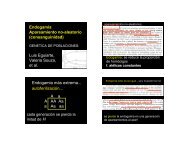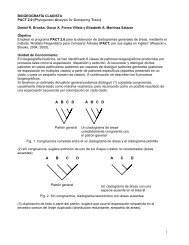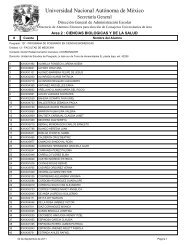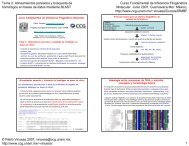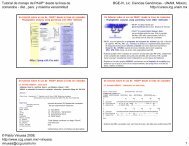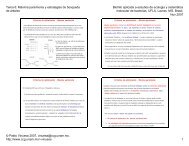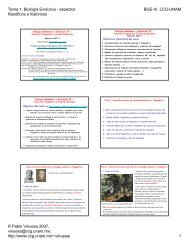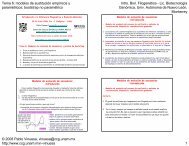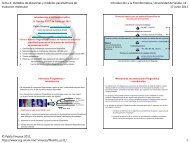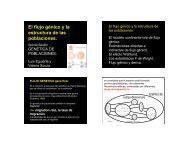Chromosome Structure
Chromosome Structure
Chromosome Structure
You also want an ePaper? Increase the reach of your titles
YUMPU automatically turns print PDFs into web optimized ePapers that Google loves.
<strong>Chromosome</strong> <strong>Structure</strong>binds RNA. Although HU shows a preference forstructurally ‘bendable’ sequences, it binds DNA relativelynonspecifically, forming complexes that stabilize negativesupercoils in double-stranded DNA (Figure 1). In phage Mutransposition reactions, HU binds to a flexed DNAstructure called a transpososome with high affinity andspecificity.H-NS is a second relatively nonspecific DNA-bindingprotein that forms dimers, tetramers and possibly higherorderassociations when bound to DNA. Like HU, H-NSconstrains negative supercoils. H-NS binds ‘bendable’DNA, which include AT-rich sequences often found nearbacterial promoters; H-NS also modulates the transcriptionofnumerous operons in E. coli and oflysogenicphages.FIS protein forms homodimers and binds DNA atspecific sites. FIS was discovered nearly simultaneously intwo related site-specific recombination systems: the Hininversion reaction of Salmonella typhimurium and the Gininversion reaction ofphage Mu. FIS concentration rises inearly log phase when the protein has regulatory roles inreplication initiation at oriC and transcription ofribosomalRNA operons, and then FIS abundance declines instationary phase.IHF protein is composed oftwo subunits (encoded bythe himA and hip genes) that are about 100 amino acidslong and which make stable heterodimers. IHF proteinbinds to a consensus sequence that was first discovered inphage l, where it stimulates insertional and excisionalrecombination in vitro by a factor of 10 4 . IHF bends DNAseverely (more than 908); such bends are critical for sitespecificrecombination in l, for repression and activationofphage Mu, and for repression–activation in a number ofcellular operons, including ilv, oxyR and nifA.In the eukaryotic nucleus, enzymes such as RNApolymerase gain access to DNA, which remains histonebound throughout most biochemical transactions. Theway in which multiple proteins interact with nucleosomecoatedDNA is not completely understood; however,protein access to DNA is modulated by histone structure.Histone phosphorylation and acetylation change chromatinstructure. Genes that are transcribed contain nucleosomeswith acetylated subunits ofhistones H3 and H4,whereas inactive genes are bound by histones lackingactetyl groups. In addition to the histones, eukaryoticchromosomes contain regulatory proteins that are muchless abundant. One class ofproteins, the high mobilitygroup (HMG) family of DNA-binding proteins, bendsDNA much like bacterial proteins IHF and FIS.DNA ReplicationThe central problem in chromosome replication isgenerating two high-fidelity DNA copies and distributingthem precisely to compartments that become the daughtercells. To control chromosomal replication temporally, andto integrate DNA metabolism with other aspects ofthe cellgrowth such as membrane synthesis and cell wall expansion,E. coli makes a master regulator, the DnaA protein,which controls the onset ofreplication at a site called oriC.The bacterial replication cycle can be described byprogression through four stages. Less detail is available foreukaryotes, but many points are similar. As cells grow, themass ofprotein and membrane increases to a critical pointthat triggers the initiation ofreplication. Two replisomesare associated in a ‘factory’ that moves to the cell centreduring chromosomal elongation. As DNA strands arepulled to the centre, replicated sister chromosomes migratetoward opposite cell poles. Completion ofDNA synthesisoccurs as the DNA that is pulled into the factory reachesthe terminus. At this point, chromosomes are tangledtogether (catenated), and all physical connections must beremoved to allow final separation. When physical separationis complete, cell wall synthesis forms two daughtercells.InitiationDNA replication starts at oriC near position 2 85 ofthestandard E. coli genetic map (Figure 2). Initiation involvesthe DnaA protein-assisted assembly oftwo replisomes,each dedicated to replicate halfa chromosome. Replisomecomponents include: the DnaB helicase, which is an ATPdependentring that moves along a single strand breakingopen the double helix for polymerase access; a dimericDNA polymerase molecule with accessory cofactors; and acomplex called the primosome that triggers RNA-primedinitiation ofnew DNA strands on one side ofthe growingfork. Each replisome has a pair of polymerase subunits:one synthesizes DNA continuously along the strand with5’–3’ polarity, and the other subunit synthesizes DNAdiscontinuously in small fragments called Okazaki pieces.Thus DNA replication is semidiscontinuous.In eukaryotic replication, initiation steps are not as fullyunderstood as they are in E. coli. Initiation occurs at arssites, so called because they are autonomously replicatingsequences (Figure 3). Initiation is controlled by a group ofproteins called ORC (origin replication complex). Typically,a chromosome has many ORC-binding sites, andbidirectional semidiscontinuous forks move out fromseveral ars sites on each chromosome until they convergewith other forks. Eukaryotic replication also occurs in‘factories’, and most of the chromosome is replicated in asemiconservative and semidiscontinuous mode, as in E.coli. The eukaryotic replication fork behaves very similarlyto that found in E. coli.4 ENCYCLOPEDIA OF LIFE SCIENCES / & 2001 Macmillan Publishers Ltd, Nature Publishing Group / www.els.net



